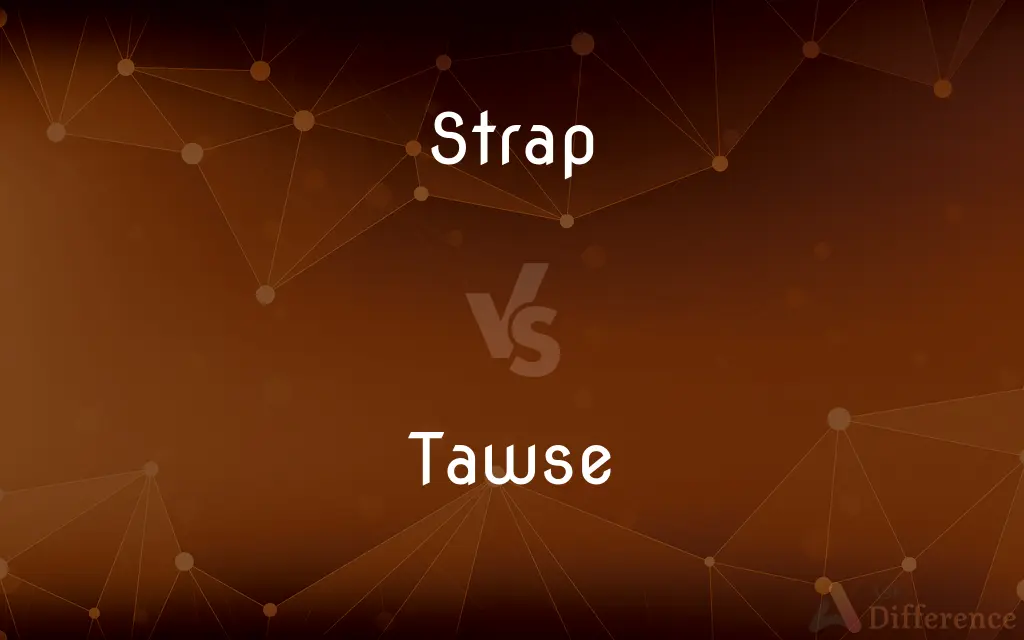Strap vs. Tawse — What's the Difference?
By Fiza Rafique & Urooj Arif — Updated on April 9, 2024
A strap is a narrow piece of fabric for securing or carrying, while a tawse is a leather implement for corporal punishment.

Difference Between Strap and Tawse
Table of Contents
ADVERTISEMENT
Key Differences
Straps are versatile, used in various contexts from securing items to being part of clothing or accessories. They can be made from various materials, including leather, cloth, and synthetic fibers, depending on their intended use. For example, straps on backpacks distribute weight across the shoulders, while watch straps secure the watch to the wrist. Whereas, a tawse, specifically designed for corporal punishment, is traditionally made from leather. It is characterized by its split end, which differentiates it from other disciplinary tools. Originating in Scotland, the tawse was commonly used in schools until such punishments were phased out.
While straps are integral to the function and design of many items, serving to secure, tighten, or hold objects in place, tawses have a singular purpose related to discipline and punishment. Straps may be adjustable to accommodate different sizes and requirements, enhancing the usability of items like belts, bags, and cameras. On the other hand, the design of a tawse is relatively straightforward, focusing on delivering a specific type of impact to the recipient.
In terms of production and design, straps can be highly customized. They come in various widths, lengths, colors, and with different types of buckles and clasps. This variety allows them to meet a wide range of functional and aesthetic needs. In contrast, tawses, though varying in size and thickness, traditionally adhere to a more uniform design, prioritizing functionality over aesthetics.
The cultural and historical significance of straps and tawses also differs markedly. Straps have been used throughout history for practical purposes, from ancient times to modern days, reflecting changes in technology, fashion, and materials. Tawses have a more specific cultural context, closely associated with educational discipline in certain regions and periods, reflecting changing attitudes towards corporal punishment and discipline over time.
Straps play a role in safety, such as in seat belts and child car seats, emphasizing their importance in everyday safety measures. Conversely, the use of the tawse has been a subject of controversy, highlighting debates around the ethics of corporal punishment and its impact on individuals, which has led to its decline in use and legal status in many places.
ADVERTISEMENT
Comparison Chart
Material
Varied (leather, cloth, synthetic)
Leather
Purpose
Securing, carrying, or fashion
Corporal punishment
Design
Adjustable, various lengths/widths
Typically uniform, with a split end
Use Context
Wide-ranging (fashion, safety, sports)
Educational discipline (historically)
Cultural Significance
Practical and aesthetic roles in history
Associated with educational discipline and its evolution
Compare with Definitions
Strap
A strap is a flexible band or ribbon, often made of fabric or leather, used to fasten, secure, or carry objects.
He adjusted the strap of his guitar before starting the performance.
Tawse
The tawse is a leather strap traditionally used for corporal punishment, often featuring one or more splits at the end.
The headmaster kept a tawse in the drawer for disciplinary measures.
Strap
Safety straps, such as seat belts, are designed to secure the wearer in vehicles.
Before starting the car, he fastened his seat belt strap.
Tawse
Originating in Scotland, the tawse was used in schools to discipline students by striking their hands.
In the past, teachers in Scottish schools used a tawse for punishment.
Strap
In fashion, a strap refers to the part of clothing or accessories that goes over the shoulder or around the waist.
She chose a dress with thin straps for the summer party.
Tawse
The tawse became a symbol of strict discipline and authority in educational settings.
Memories of the tawse reminded him of the strict discipline in his old school.
Strap
Straps are used in sports equipment, securing gear and providing support.
The yoga mat came with a carrying strap for easy transportation.
Tawse
The use of the tawse has been largely abolished in modern educational systems due to changing views on corporal punishment.
The legal ban on corporal punishment led to the disappearance of the tawse from classrooms.
Strap
Straps are integral components of bags, watches, and shoes, often adjustable for comfort and fit.
The backpack’s padded straps make it comfortable to carry heavy loads.
Tawse
Different sizes and thicknesses of tawses were used to administer varying degrees of punishment.
The senior students often received punishment with a thicker tawse.
Strap
A strap, sometimes also called strop, is an elongated flap or ribbon, usually of leather or other flexible materials. Thin straps are used as part of clothing or baggage, or bedding such as a sleeping bag.
Tawse
The tawse, sometimes formerly spelled taws (the plural of Scots taw, a thong of a whip) is an implement used for corporal punishment. It was used for educational discipline, primarily in Scotland, but also in schools in a few English cities e.g.
Strap
A long narrow strip of pliant material such as leather.
Tawse
A leather strap or thong which is split into (typically three) tails, used for corporal punishment in schools, applied to the palm of the hands or buttocks.
Strap
Such a strip equipped with a buckle or similar fastener for binding or securing objects.
Tawse
To beat with a tawse.
Strap
A thin flat metal or plastic band used for fastening or clamping objects together or into position.
Tawse
A leather strap for punishing children
Strap
A narrow band formed into a loop for grasping with the hand.
Strap
A razor strop.
Strap
A strip of leather used in flogging.
Strap
To fasten or secure with a strap.
Strap
To beat with a strap.
Strap
To sharpen (a razor, for example).
Strap
A long, narrow, pliable strip of leather, cloth, or the like.
Strap
A strap worn on the shoulder.
Strap
A strip of thick leather used in flogging.
Strap
Something made of such a strip, or of a part of one, or a combination of two or more for a particular use.
Strap
A piece of leather, or strip of wood covered with a suitable material, used to hone the sharpened edge of a razor; a strop.
Strap
A narrow strip of anything, as of iron or brass.
Strap
A band, plate, or loop of metal for clasping and holding timbers or parts of a machine.
Strap
(nautical) A piece of rope or metal passing around a block and used for fastening it to anything.
Strap
(botany) The flat part of the corolla in ligulate florets, as those of the white circle in the daisy.
Strap
(botany) The leaf, exclusive of its sheath, in some grasses.
Strap
(slang) A gun, normally a personal firearm such as a pistol or machine pistol.
Strap
Credit offered to a customer, especially for alcoholic drink.
Strap
(journalism) strapline
Strap
A championship belt, or by extension, the title.
Strap
(finance) An investment strategy involving simultaneous trade with one put and two call options on the same security at the same strike price, similar to but more bullish than a straddle.
Strap
(transitive) To beat or chastise with a strap; to whip, to lash.
Strap
(transitive) To fasten or bind with a strap.
Strap
(transitive) To sharpen by rubbing on a strap; to strop.
To strap a razor
Strap
A long, narrow, pliable strip of leather, cloth, or the like; specifically, a strip of thick leather used in flogging.
A lively cobbler that . . . had scarce passed a day without giving her [his wife] the discipline of the strap.
Strap
Something made of such a strip, or of a part of one, or a combination of two or more for a particular use; as, a boot strap, shawl strap, stirrup strap.
Strap
A piece of leather, or strip of wood covered with a suitable material, for sharpening a razor; a strop.
Strap
A narrow strip of anything, as of iron or brass.
Strap
A band, plate, or loop of metal for clasping and holding timbers or parts of a machine.
Strap
The flat part of the corolla in ligulate florets, as those of the white circle in the daisy.
Strap
A piece of rope or metal passing around a block and used for fastening it to anything.
Strap
A shoulder strap. See under Shoulder.
Strap
To beat or chastise with a strap.
Strap
To fasten or bind with a strap.
Strap
To sharpen by rubbing on a strap, or strop; as, to strap a razor.
Strap
An elongated leather strip (or or strip of similar material) for binding things together or holding something in position
Strap
Hanger consisting of a loop of leather suspended from the ceiling of a bus or train; passengers hold onto it
Strap
A band that goes over the shoulder and supports a garment or bag
Strap
Whip consisting of a strip of leather used in flogging
Strap
Tie with a strap
Strap
Beat severely with a whip or rod;
The teacher often flogged the students
The children were severely trounced
Strap
Sharpen with a strap;
Strap a razor
Strap
Secure (a sprained joint) with a strap
Common Curiosities
How does a tawse differ from a belt in terms of design?
A tawse is specifically designed with one or more splits at the end, which differentiates it from a typical belt.
Are all straps adjustable?
Many straps are adjustable to accommodate different sizes and uses, but not all straps have this feature.
What led to the decline in the use of the tawse?
Changing attitudes towards corporal punishment and legal bans led to the decline in the use of the tawse.
What are some common uses for straps?
Straps are used in a variety of ways, including securing items, as part of clothing or accessories, and in safety equipment.
What materials are straps made from?
Straps can be made from leather, fabric, synthetic materials, and more, depending on their intended use.
What cultural significance does the tawse hold?
The tawse holds cultural significance in regions where it was traditionally used, symbolizing strict educational discipline.
Can straps be considered fashion accessories?
Yes, straps are often integral to the design of fashion accessories, like handbags and watches, and can be decorative.
Why was the tawse used in schools?
The tawse was used as a form of corporal punishment to discipline students for misbehavior.
How were tawses typically used in punishment?
Tawses were used to strike the hands or sometimes the buttocks as a form of punishment.
Can a strap be a safety device?
Yes, straps such as seat belts act as safety devices in vehicles, designed to secure the wearer.
How do straps enhance the usability of products?
Straps make products more portable, secure, and adjustable, enhancing their functionality and comfort.
Is the tawse still used today?
The tawse is rarely used today, with its use in schools and other institutions largely abolished.
Share Your Discovery

Previous Comparison
Dramatic vs. Drama
Next Comparison
Signboard vs. BillboardAuthor Spotlight
Written by
Fiza RafiqueFiza Rafique is a skilled content writer at AskDifference.com, where she meticulously refines and enhances written pieces. Drawing from her vast editorial expertise, Fiza ensures clarity, accuracy, and precision in every article. Passionate about language, she continually seeks to elevate the quality of content for readers worldwide.
Co-written by
Urooj ArifUrooj is a skilled content writer at Ask Difference, known for her exceptional ability to simplify complex topics into engaging and informative content. With a passion for research and a flair for clear, concise writing, she consistently delivers articles that resonate with our diverse audience.
















































